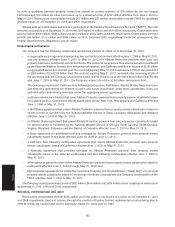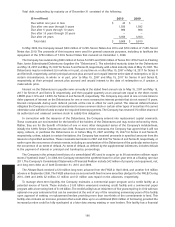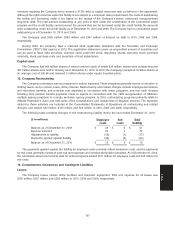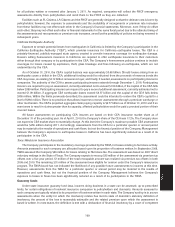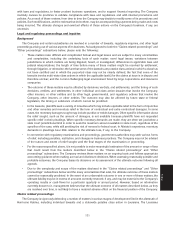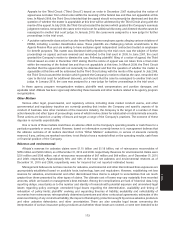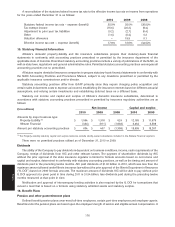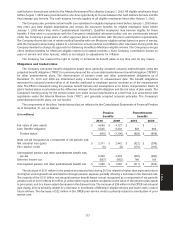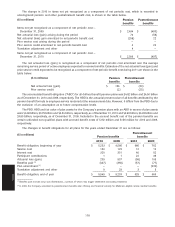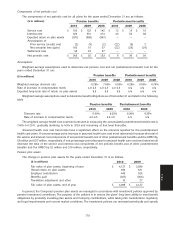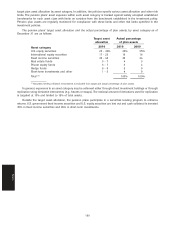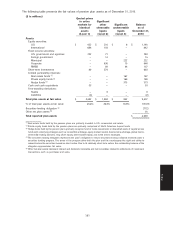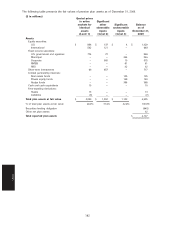Allstate 2011 Annual Report Download - page 252
Download and view the complete annual report
Please find page 252 of the 2011 Allstate annual report below. You can navigate through the pages in the report by either clicking on the pages listed below, or by using the keyword search tool below to find specific information within the annual report.
Attorney General filed a putative class action lawsuit in state court against Allstate and other insurers on behalf of Road
Home fund recipients alleging that the insurers have failed to pay all damages owed under their policies. The insurers
removed the matter to federal court. The district court denied plaintiffs’ motion to remand the matter to state court and
the U.S. Court of Appeals for the Fifth Circuit (‘‘Fifth Circuit’’) affirmed that ruling. The defendants filed a motion to
dismiss and the plaintiffs filed a motion to remand the claims involving a Road Home subrogation agreement. In March
2009, the district court denied the State’s request that its claims be remanded to state court. As for the defendant
insurers’ motion, the judge granted it in part and denied it in part. Dismissal of all of the extra-contractual claims,
including the bad faith and breach of fiduciary duty claims, was granted. Dismissal also was granted of all claims based
on the Valued Policy Law and all flood loss claims based on the levee breaches finding that the insurers flood exclusions
precluded coverage. The remaining claims are for breach of contract and for declaratory relief on the alleged
underpayment of claims by the insurers. The judge did not dismiss the class action allegations. The defendants also had
moved to dismiss the complaint on grounds that the State had no standing to bring the lawsuit as an assignee of
insureds because of anti-assignment language in the insurers’ policies. The judge denied the defendants’ motion for
reconsideration on the assignment issue but found the matter was ripe for consideration by the federal appellate court.
The defendants have filed a petition for permission to appeal to the Fifth Circuit. The Fifth Circuit has accepted review.
After the Fifth Circuit accepted review, plaintiffs filed a motion to remand the case to state court, asserting that the class
claims on which federal jurisdiction was premised have now effectively been dismissed as a result of a ruling in a related
case. The Fifth Circuit has denied the motion for remand, without prejudice to plaintiffs’ right to refile the motion for
remand after the Fifth Circuit disposes of the pending appeal. On July 28, 2010, the Fifth Circuit issued an order stating
that since there is no controlling Louisiana Supreme Court precedent on the issue of whether an insurance policy’s
anti-assignment clause prohibits post-loss assignments, the Fifth Circuit is certifying that issue to the Louisiana
Supreme Court. The issue has been briefed to the Louisiana Supreme Court. That court will hold oral argument on the
appeal on March 14, 2011.
There are one nationwide and several statewide class action lawsuits pending against Allstate alleging that it failed
to properly pay general contractors overhead and profit on many homeowner structural loss claims. Most of these
lawsuits contain counts for breach of contract, as well as one or more counts asserting other theories of liability such as
bad faith, fraud, unjust enrichment, or unfair claims practices. General contractors overhead and profit is an amount that
is added to payments on claims where the services of a general contractor are reasonably likely to be required. To a
large degree, these lawsuits mirror similar lawsuits filed against other carriers in the industry, some of which have
settled. These lawsuits are pending in various state and federal courts, and they are in different stages of development.
The Company has reached an agreement to settle on a 48-state basis the nationwide class action. This settlement
received preliminary approval from the court on December 6, 2010, and the case was certified as a class for settlement
purposes only. The settlement was accrued as a prior year reserve reestimate in property-liability insurance claims and
claims expense in 2010. No other classes have been certified against Allstate on this issue. The hearing for final approval
of the settlement is scheduled for May 6, 2011.
Allstate has been vigorously defending a lawsuit in regards to certain claims employees involving worker
classification issues. This lawsuit is a certified class action challenging a state wage and hour law. In this case, plaintiffs
sought monetary relief, such as penalties and liquidated damages, and non-monetary relief, such as injunctive relief. In
December 2009, the liability phase of the case was tried, and, on July 6, 2010, the court issued its decision finding in
favor of Allstate on all claims. The plaintiffs are appealing the decision.
Other proceedings
The Company is defending certain matters relating to the Company’s agency program reorganization announced in
1999. These matters are in various stages of development.
• These matters include a lawsuit filed in 2001 by the U.S. Equal Employment Opportunity Commission (‘‘EEOC’’)
alleging retaliation under federal civil rights laws (the ‘‘EEOC I’’ suit) and a class action filed in 2001 by former
employee agents alleging retaliation and age discrimination under the Age Discrimination in Employment Act
(‘‘ADEA’’), breach of contract and ERISA violations (the ‘‘Romero I’’ suit). In 2004, in the consolidated EEOC I
and Romero I litigation, the trial court issued a memorandum and order that, among other things, certified
classes of agents, including a mandatory class of agents who had signed a release, for purposes of effecting
the court’s declaratory judgment that the release is voidable at the option of the release signer. The court also
ordered that an agent who voids the release must return to Allstate ‘‘any and all benefits received by the [agent]
in exchange for signing the release.’’ The court also stated that, ‘‘on the undisputed facts of record, there is no
basis for claims of age discrimination.’’ The EEOC and plaintiffs asked the court to clarify and/or reconsider its
memorandum and order and in January 2007, the judge denied their request. In June 2007, the court granted
the Company’s motions for summary judgment. Following plaintiffs’ filing of a notice of appeal, the U.S. Court of
172
Notes


